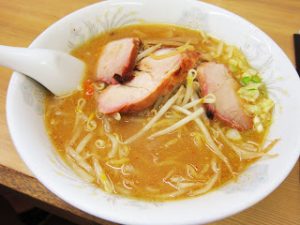Tonkotsu ramen
Tonkotsu (pork bone) ramen usually has a cloudy white colored broth. It is similar to the chinese paitan soup and has a thick broth made from boiling pork bones, fat, and collagen over high heat for many hours, which suffuses the broth with a hearty pork flavor and a creamy consistency that rivals milk, melted butter or gravy. Most shops, but not all, blend this pork broth with a small amount of chicken and vegetable stock and/or soy sauce.
The noodles are thin and straight, and it is often served with beni shoga (pickled ginger). In recent years the latest trend in tonkotsu toppings is māyu (sesame oil), a blackish, aromatic oil made from either charred crushed garlic or Sesame seeds.
Tonkotsu ramen is originated in Kyushu and is very popular.
Hakata ramen (Fukuoka, Kyushu)
It is a specialty of Kyushu, particularly Hakata-ku, Fukuoka.
Usually uses a lightly flavored white soup made from boiled pork bones and vegetables, and very thin, straight noodles.
Many shops offering tonkotsu ramen (noodle with a thick broth made from boiling pork bones) including Hakata ramen shops prepare takanazuke stir-fried in oil with red pepper to top ramen with.

Kurume ramen (Fukuoka, Kyushu)
Said to be the origin of ramen noodles in Kyushu, its trademark cloudy white pork-based soup has a renowned unique flavor and richness, and the taste is second to none.

Kumamoto ramen (Kumamoto, Kyushu)
A very rich, white soup is made from a mixture of pork bone stock and chicken stock.
It is considered a derivative of the thick type owing to its distinct sweet and thick soup which is mixed with chicken bone.
A medium sized,straight noodle is usually preferred.

Kagoshima ramen (Kagoshima, Kyushu)
Its soup is mainly based on tonkotsu (pork bone broth). It is a little cloudy, and chicken stock, vegetables, dried sardines, kelp and dried mushrooms are added.
The size of the noodle is a bit thicker than normal. Compared with other local varieties of ramen, the size of the noodle and the taste of the soup are very different; each shop has separate recipes. It is served with pickled daikon.

Thank you.
OSECHI-RYORI
Japanese traditional New Year’s Cuisine is called OSECHI-RYORI.
It is also simply called OSECHI.
People enjoy Osechi in the first 3 days of January.
It is cooked to keep for at least three days and women do not have to cook during the period. You will see many different and beautiful dishes set in a 3 or 4-tiered box which an overlay.
The diversity of Osechi means differently such as good health, harvest, happiness, prosperity, long-lived life and so on respectively.
For Example
Kuromame (simmered black soy beans) is for good health.
Tazukuri (candied dried sardines) is for good harvest.
Kurikinton (mashed sweet potato with sweet chestnuts) means improvement of luck with money.
Kazunoko (salted herring roe) symbolizes fertility.
Prawns symbolize long-lived life.


Well then, see you later.
Miso ramen
Soup stock for ramen may be made from seafood, chicken bones, pork bones or various other ingredients.
It is seasoned with soy sauce, miso, salt and other flavorings depending on the region.
This time I will introduce miso ramen.
Miso ramen is ramen noodles in a Miso based soup that was created in Japan in the 1960s.
Miso ramen soup is flavored with soybean paste, resulting in a thick soup with a rich flavor.
Flavored with pork and chicken broth with a mix of toppings such as chashu, ramen egg, sweet corn kernels, nori sheet, this bowl of noodles is going to satisfy your craving.
Famous miso ramen…
Sapporo ramen
Miso ramen seasoned with hot and spicy miso and garlic.
The ramen noodles are boiled in a soup with vegetables that have been fried in plenty of lard and garlic.



Thank you.
About the sushi
Sushi is known as a healthy food , and it has become increasingly popular.
You can see more and more sushi restaurants in most of the cities in the world.
Especially the so-called creative sushi is introduced and innovated by chefs around the world.
The creative-sushi using fruit or a new seasoning delights Japanese people.
There are various styles of Japanese traditional sushi such as Nigiri-sushi,
Chirashi-sushi, Maki-sushi and Oshi-sushi.
 |
| Nigiri-sushi |
 |
| Oshi-sushi |
 |
| Maki-sushi |
And Inari-sushi, Temari-sushi Gunkanmaki, as well.
 |
| Temari-sushi |
 |
| Inari-sushi |
 |
| Gunkanmaki |
That’s very beautiful, and tasty. I would like to introduce traditional Japanese cuisine.
See you later.



